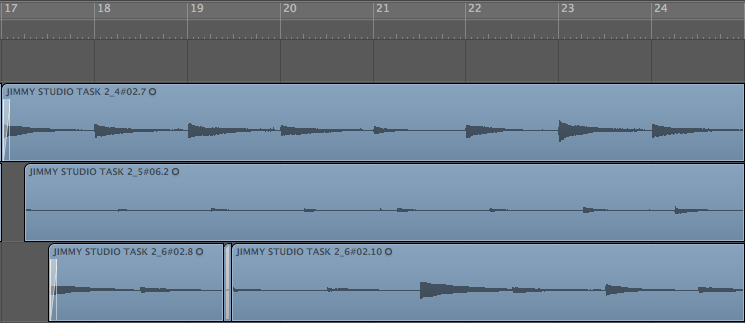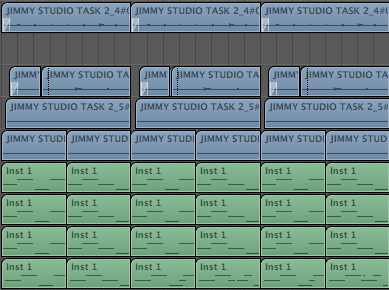Assessment 1
I first began this compositional assessment by researching groundbreaking influential producers who use non-conventional production ideology regarding their music. I was predominately interested in emulating some ideas from the greatest experimental producer master minds such as Brian Eno, Phil Spector, Frank Zappa, Pierre Schaeffer, Kraftwerk and Aphex Twin – yet decided only utilise some production techniques explained by Brian Eno, Frank Zappa and my own ‘digitalised’ version of Phil Spector’s ‘Wall of Sound’.
This is all the equipment and software I used to create my composition:
- iMac
- Focusrite 2i4 Audio Interface
- KRK Rockit 6 Studio Monitors
- Logic Pro 9
- Native Instruments: Massive (Subtractive Synthesiser)
- Ibanez Electric Guitar
- Alesis QX25 MIDI Keyboard
- AKG C1000 Condensor Microphone
Oblique Strategy – Brian Eno
Before I dive into detail about this assessment I need to explain one of the most useful production techniques I have ever used. If you are like me, sometimes while composing a piece of music you may hit a brick wall and sit there blank for hours on end asking yourself “What can I do now?” or maybe you are not happy with a section of the song. Well why not use Brian Eno’s ‘Oblique Strategy Cards’.
He developed a list of prompts that push you to think outside the box for either a on-the-fly creative composition or simply because you’re stuck. Personally I used an online website that randomly gives you a prompt but physical cards are available online to purchase. Some examples of these prompts include:
- What is the simplest solution?
- Don’t be afraid of things because they are easy to do
- What would your closest friend do?
- Convert a melody element into a rhythmic element
Useful website for some free oblique strategies: http://www.oblicard.com/
Purchase official cards here: http://www.enoshop.co.uk/product/oblique-strategies.html
£30 for a deck of cards – ouch! But can you put a price on instant creativity?
Heterophony – Brian Eno
The basic idea of this piece is to replicate something similar to Brian Eno’s ‘Discreet Music’ which is a piece of music that uses this idea of heterophony. So what is heterophony? Have a listen to the piece of music in question here:
Notice how the synthesisers (I’m guessing one of Eno’s own ambient pads?) play variations of the same melody at the same time. In heterophony, the melodies are only slightly different from one another in time. Other layered variations of the melody include changes of textures and timbre.
This really inspired me to try out this technique for myself, I sat down and began to write something ‘ambient sounding’ on my guitar but began getting frustrated with myself, I used an Oblique Strategy card that read ‘Make whats perfect more human.’ and I said to myself “Hey, i’m not a guitarist, I need to hand this guitar over to somebody who really can feel what i’m trying to do rather than perfect it myself.”
So I booked a studio session with my friend Frazer Robinson and began explaining my ideas and melodies with freedom to put his own spin on things – which is also interestingly enough something Eno liked to practice himself while working with musicians. My idea for the guitar was to write one single melody line over eight bars but recording different strings on three separate audio channels. I really enjoyed the first melody we wrote but I felt it wasn’t quite ‘ambient’ enough for me so I decided to keep the recordings but asked Frazer to record something new on the spot but this time much slower and more emotional.
The end result was so simple but I knew that once I began rearranging the recordings into a heterophonic style that they would sound fantastic. I came up with the idea of using both different contrasting melodies in the same track so when the first one finishes it would eventually fade into the second one, almost like two tracks in one but you know it’s the same piece of music. It was a strange idea, but it worked. The recordings themselves were recorded on my own audio interface within a studio, strangely, the recordings had a high pitched feedback on them which initially sounded quite bad… But after I had done a high-cut on the EQ just to eliminate the harsh 18KHz+ frequencies I quite liked the warmness it brought to the recording.

I also layered multiple synthesised MIDI tracks using a subtractive synthesiser called Massive by Native Instruments. This tool allowed me to create two different pads, one high pitched pad and one bass pad. Once I had EQ’d the sub bass out of each of my patches I had space in the frequency spectrum for a sub bass. I used a slow attack and release so the sub bass was soft rather than ‘blocky’ and in your face. At this point I still felt that I wanted to really push the heterophonic ideology to the listener so I added piano using my MIDI keyboard and Logics’ built in sampler (EXS24).
I got stuck once again writing a piano section so decided to use an Eno creative prompt card and pulled ‘remove a restriction’, my restriction being my music theory and questionable keyboard skills! So I just ignored what was technically musically correct and just played what sounded good to me.

Xenochrony – Frank Zappa
Xenochrony literally means ‘Strange time’ and although I wouldn’t say I used Zappa’s technique to the extent he did (Such as recording drummers in 11/4 and putting it against a bass track from another song then layering it with a 4/4 guitar solo from something else.) I quite simply used his idea of distorting time within a given melody and putting it with the original one to create an almost polyrhythmic effect.

This is the best possible example of Zappa’s Xenochrony in his own work…
Wall of Sound – Phil Spector
Phil Spector is most remembered for his ‘Wall of Sound’ production technique. Spector achieved this sound by using an array of instruments performing the same melodies in unison. He would then record using an echo chamber and sometimes double or triple tracks to make songs sound bigger. But the reality is, I do not have access to an echo chamber or have a large array of musicians to play the same piece over and over for several hours (Yes Spector did like to do this). So instead I took his idea and tried to emulate his ideas to fit my restrictions.
I doubled every guitar track giving me six guitar tracks and glued them together making sure there was no distortion or clipping. Once the tracks were doubled I fed every channel (including synths and piano) through a reverb bus – excluding the sub bass channel of course. I used a very long reverb tail and pre delay to achieve a very full and spacious effect. I also added tape delay on several sections of the high guitar sections which are subtle but present in the mix.
End Result
And here is the end result, an ambient relaxing piece of music using new and interesting techniques which I will most certainly be using again. I had a lot of fun producing this and I found Eno’s Oblique Strategy cards to be one of the most useful tools for creating music – especially when you’re stuck!
Hope you enjoy the track.
Written by Jimmy Ostler
Resources:
Heterophony – http://www.operasquad.com/elementsofmusic/heterophonic/
Xenochrony – https://www.youtube.com/watch?v=NOsM_fEljus
http://www.zappa.com/messageboard/viewtopic.php?f=10&t=19229
Wall of Sound – https://www.youtube.com/watch?v=LRmRBrnQq8o
http://news.bbc.co.uk/1/hi/entertainment/6467441.stm